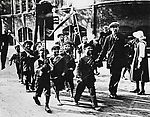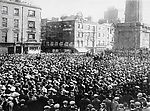 National Rail strike
National Rail strike Bermondsey jam factory strike
Bermondsey jam factory strike Dockers' strike
Dockers' strike Dublin transport workers' strike
Dublin transport workers' strike Kilbirnie net workers' strike
Kilbirnie net workers' strike

The years from 1910 to 1914 are known as "The Great Unrest". The economic instability of the preceding years, caused to some extent by other industrial nations catching up with Britain, had created uncertainty in industry, and a fall in wages caused anger amongst workers. Between 1900 and 1914 average wages fell by 10%, and trade union membership grew rapidly.
Syndicalism became a popular movement in the pre-war years. It encouraged direct action in order to regain some form of workers' control over industry, through using the strategy of the mass strike and rapid trade union recruitment. Many organisers of the strikes were inspired by these ideas.
The strike action of this period was across the country and in all industries. Many strikes led to other industries coming out in sympathy. The Chainmakers’ strike in the Black Country inspired many other unorganised groups of workers to organise and fight for a living wage. The Miners' strikes began in Wales, where a change to wages was proposed by employers. This meant that miners working difficult mines would receive low pay, as they were unable to produce as much coal. The strikes led to riots, where one miner died. The government eventually sent in the troops to enforce the peace.
Inspired by the Miners’ strike, concerns over pay and conditions led to strikes on the railways and in the docks. More deaths of strikers occurred during riots in Wales. A printers' strike in 1911, prompted the establishment of a new workers' daily newspaper in April 1912, the "Daily Herald", edited by George Lansbury. The Bermondsey strikes in the food making industry brought 14,000 workers out. A heat wave is believed to have increased the unrest, which must have been widespread, as during this period some London gun makers sold out of revolvers. Following the Trade Boards Act many women were paid a minimum wage, but this still brought them below the level of £160 per year needed to qualify for health insurance. The Net workers of Kilbirnie came out on strike, and held rallies to improve their pay, and to get trade union recognition.
By the end of this period Britain had lost 40,890,000 working days, resulting from 1,459 stoppages or strikes in the same year. Compare these figures to those of 1906 / 07 when 478 stoppages led to 2,150,000 working days being lost.
A truce was called between the Liberal Government and the trade unions, when war was declared in August 1914.
Rollover the captions in the box to see the available images in thumbnail format, click the caption to see the full-size image
| Reference: | 711 |
| Keywords: | |
| Archive Ref: | |
| Updated: | Wed 9 Jul 2008 - 10 |
| Interpretation written by | Jenny Ermoyenous |
| Author's organisation | Curatorial |
| Organisation's website |